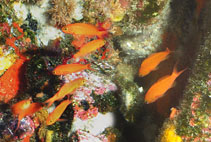| Family: |
Anthiadidae (Fairy basslets or Streamer basses) |
| Max. size: |
6.07 cm SL (male/unsexed) |
| Environment: |
demersal; marine; depth range 30 - 55 m |
| Distribution: |
Eastern Central Atlantic: endemic to St. Paul's Rocks. |
| Diagnosis: |
Dorsal spines (total): 10-10; Dorsal soft rays (total): 15-15; Anal spines: 3-3; Anal soft rays: 7-7. This species distinguished from it congeners by the following set of characters: A 7; 46-51 lateral-line scales; total gill rakers on first arch 32-35 (Ref. 90266). |
| Biology: |
This species, which was seen again at St. Paul's Rocks after almost 30 years of its first description, was observed between 35 and 55 m and was most abundant between 40 and 45 m on almost-vertical rock drop offs. It aggregates in small groups of 5 to 10 individuals, swimming close to crevices into which they hide when threatened. Several such groups were observed, with each group taking refuge in its own crevice when approached by a diver. Apparently, there is no exchange of individuals between groups or crevices, suggesting that appropriate shelter is one of the factors limiting the distribution of this species. Individuals were observed to leave a shelter only when a school of juvenile Chromis multilineata (Guichenot, 1853) approached the cliffs. Both species are quite similar in shape and, at depths with available light, are almost identical in coloration (faded-brown). Presumably, A. salmopunctatus gets protective advantages of schooling with a similar species in larger, multispecific groups while foraging on open water plankton. Although neither A. salmopunctatus nor other endemic fishes in the area may be under great risk of extinction (as their habitat is not directly affected by human activities), such extreme restricted geographic distribution is sufficient to consider the species threatened, as they could be vulnerable to natural impacts. A. salmopunctatus and Prognathodes obliquus have been reported show low densities and seem to have low absolute numbers. The latter may be a bias due to the fact that only the shallow portion of the depth range is being sampled or, alternatively, the species really have low population densities. A precise evaluation of the risks of extinction urgently requires extensive work to better estimate the distribution and population size of this species (Ref. 58184). |
| IUCN Red List Status: |
Least Concern (LC); Date assessed: 10 June 2013 Ref. (130435)
|
| Threat to humans: |
harmless |
Source and more info: www.fishbase.org. For personal, classroom, and other internal use only. Not for publication.
